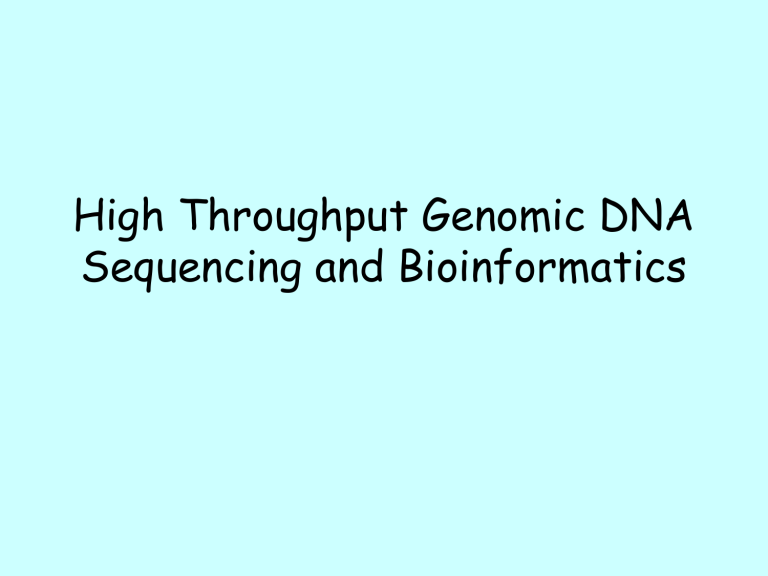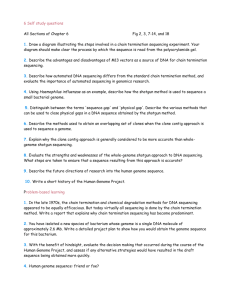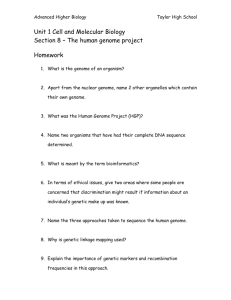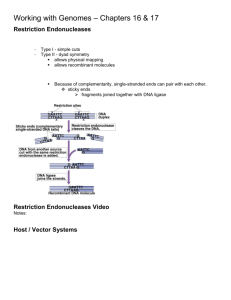Genomic Sequencing

High Throughput Genomic DNA
Sequencing and Bioinformatics
The Human Genome Project
• The Human genome is now officially sequenced.
• That was a big job.
• How did they do it?
• Is there anything that a knowledge of bioinformatics tells us that we should watch out for in the human genome sequence?
What is DNA Sequencing?
• A DNA sequence is the order of the bases on one strand.
• By convention, we order the DNA sequence from 5’ to 3’, from left to right.
• Often, only one strand of the DNA sequence is written, but usually both strands have been sequenced as a check.
DNA Sequencing was Awarded the Nobel Prize
• Walter Gilbert and Fred Sanger were awarded the Nobel Prize in Chemistry for the development of two different methods of DNA sequencing.
• http://www.nobel.se/chemistry/laureat es/1980/
• (Oh yes, and Paul Berg for Recombinant
DNA- a big year!)
Two Methods of DNA
Sequencing
• Maxam - Gilbert Method, in which a DNA sequence is end-labeled with [P-32] phosphate and chemically cleaved to leave a signature pattern of bands.
• Sanger Method, in which a DNA sequence is annealed to an oligonucleotide primer, which is then extended by DNA polymerase using a mixture of dNTP and ddNTP (chain terminating) substrates. This is the main method used now.
Sanger Method is a Form of
DNA Synthesis
• DNA to be sequenced acts as a template for the enzymatic synthesis of new DNA strand starting at a defined primer.
• Polymerases used are Pol I type polymerases.
• Incorporation of a dideoxynucleotide blocks further synthesis of the new
DNA strand.
Remember the Rules of In Vivo DNA Replication
Remember the Rules of In Vivo DNA Replication
How the Reaction Works
• If the DNA is double stranded, the reaction is started by heating until the two strands of DNA separate.
• Lower the temperature and the primer sticks to its intended location by H bonds.
• DNA polymerase starts elongating the primer.
• If allowed to go to completion, a new strand of DNA would be the result.
How the Reaction Works
• If we start with a billion identical pieces of template DNA, we'll get a billion new copies of one of its strands.
• We run the reactions, however, in the presence of a dideoxyribonucleotide.
• This is just like regular DNA, except it has no 3' hydroxyl group - once it's added to the end of a DNA strand, there's no way to continue elongating it.
Original Sanger Sequencing
• A mixture of dNTPs and a single ddNTP is used in the reaction tubes.
• We can start with 4 different reaction tubes, each with all four dNTPS (dATP, dGTP, dTTP, dCTP) and ONLY one of either ddA, ddC, ddG and ddT (only 1%).
• The key is MOST of the nucleotides are regular ones, and just a fraction of them are dideoxynucleotides.
An Example of a T tube:
• MOST of the time when a 'T' is required to make the new strand, the enzyme will get a good one and it continues to elongate.
• MOST of the time after adding a T, the enzyme will go ahead and add more nucleotides.
• However, about 1% of the time, the enzyme will get a dideoxy-T, and that strand can never again be elongated.
• It eventually breaks away from the enzyme, leaving a dead end DNA that can’t be further extended.
Original Sanger Sequencing
• Sooner or later ALL of the copies will get terminated by a T.
• But each time the enzyme makes a new strand, the place it gets stopped will be random.
• In millions of starts, there will be strands stopping at every possible T along the way.
Specific Primers Start the
Sequence
• ALL of the strands we make started at one exact position.
• ALL of them end with a T. There are billions of them ... many millions at each possible T position.
• To find out where all the T's are in our newly synthesized strand, all we have to do is find out the sizes of all the terminated products!
Non-Radioactive DNA Labels
• Add a chemical tag to each ddNTP that can emit a fluorescent color when excited by a laser.
• We can add a different dye to each ddNTP and each is excited by a different laser wave length.
• Run the reactions in only one tube, not 4 tubes!
• This is easier and faster. A big contribution to high throughput sequencing.
Automated DNA Sequencing
• We don't even have to 'read' the sequence from the gel - the computer does that for us!
• This is a plot of the colors detected in one
'lane' of a gel (one sample), scanned from smallest fragments to largest.
• The computer even interprets the colors by printing the nucleotide sequence across the top of the plot.
• This is just a fragment of the entire file, which would span around 700 or so nucleotides of accurate sequence.
Automated DNA Sequence Readouts
The Biology of DNA Sequencing
• Virtually all DNA sequencing, (both automated and manual) relies on the Sanger method
– DNA replication with dideoxy chain termination
– separation of the resulting molecules by polyacrylamide gel electrophoresis.
• The DNA fragment to be sequenced must first be cloned into a vector (plasmid or lambda).
– Then the cloned DNA must be copied in a test tube
(in vitro ) by a DNA polymerase enzyme to obtain a sufficient quantity to be sequenced.
Sample DNA Sequence
from ABI sequencer
Automated sequencing machines, particularly those made by PE
Applied Biosystems, use 4 colors of dye, so they can read all 4 bases at once.
Challenges of DNA Sequencing
• One technician with an automated DNA sequencer can produce over 20 KB of raw sequence data per day.
• The real challenge of DNA sequencing is in the analysis of the data
J. Craig Venter
• Proposed a whole-genome shotgun sequencing method to NIH in 1991. Proposal rejected.
• Sets up The Institute for Genomic Research
(TIGR) in 1992 (private and non-profit)
• TIGR publishes the first complete genome sequence in 1995 (Haemophilis influenzae)
• Forms Celera Genomics in 1998 to sequence human genome in three years (private, forprofit)
• The Sequence of the Human Genome is published in Science. February 2001
• Venter departs Celera. 2002
Human Genome Project
Sequencing Strategy
• Clone-based physical mapping
• Digest genome and make Bacterial
Artificial Chromosomes (BACs, 150,000 bp each)
• Digest BACs to create fingerprints
• Organize BACs to form contigs
• Select BAC clones for sequencing
• Shear BACs and shotgun clone
• Sequence clones and assemble overlaps
Celera Sequencing Strategy
• Whole-genome shotgun sequencing of five individuals with 5 fold coverage
• Computer assembles overlapping sequences to form contigs
• Contigs are assembled into scaffolds
• Scaffolds are mapped to the genome by two or more Sequence Tagged Site
(STS) markers
Technology Breakthroughs
• Development of Expressed Sequence Tag
(EST) method to discover and map human genes
• Development of Bacterial Artificial
Chromosomes (BACs) to clone large DNA fragments
• Development of an automated highthroughput capillary DNA sequencer in
1998 (Applied Biosystems ABI PRISM
3700 DNA Analyzer)
• Development of powerful computers and software to analyze sequence data
Genome Questions
• Has every base in our genome been sequenced?
• What is the total number of genes and where are they located?
• How many genes have an unknown function?
• What percent of our DNA encodes genes and what is the remainder?
• Do we share DNA sequences with other organisms?
• How much sequence variation is there between individuals?
Genome Sequencing
HTG, GSS,(WGS)
Whole BAC insert (or genome) shredding sequencing
GSS division or trace archive assembly cloning isolating
Draft Sequence
(
HTG division
)
T7 end
GSS Division: Genome Survey
Sequences
•Genomic equivalent of ESTs
•BAC and other first pass surveys
•BAC end sequences
•Whole Genome Shotgun (some)
•RAPIDS and other anonymous loci
SP6 end
Genomic Clone (BAC)
Working Draft Sequence
gaps
Technology Limitations
• Sequences can only be determined in approximately 400-800 base pair sections known as “reads.”
– This is due to both the biochemistry of the
DNA polymerase enzyme and the resolution of polyacrylamide gel electrophoresis.
– Most genes contain many thousands of bp and many modern sequencing projects are intended to produce complete sequences of large genomic regions (millions of bp)
Assembly of Contigs
• As a result, all sequencing projects must involve the division of the target DNA into a set of overlapping
~500 bp fragments.
• Then these fragments are assembled into complete sequences (contigs)
Contig = contiguous sequenced region
• Assembly of overlapping fragments is a computational problem
Contig Assembly Problems
1) The 500 bp reads of sequence data have errors of both incorrectly determined bases and insertions/deletions.
2) The error rate is highest at the beginning and ends of the reads - precisely the regions that must be overlapped.
3) Some sequence from cloning vectors is often included at the ends of sequence reads.
Sequence Assembly Algorithms
• Different than similarity searching
• Look for ungapped overlaps at end of fragments
– (method of Wilbur and Lipman, (SIAM J. Appl. Math. 44;
557-567, 1984)
• High degree of identity over a short region
• Want to exclude chance matches, but not be thrown off by sequencing errors
• Vector removal uses similar approach, but less stringent
– should recognize small regions of identity and tolerate more mismatches
Celera Innovation: Clone End Tracking
• Create 3 libraries with 2, 10, and 50 KB inserts
• Use information from clone ends: distance and orientation
– Can span some gaps between contigs and determine the size of gaps
Overlap at ends, not internal
Software determines strategy
Based on their faith in the speed and reliability of sequence analysis/assembly software, researchers have generally taken one of three different approaches to planning sequencing projects:
• Ordered sub-cloning
• Primer walking
• Shotgun sequencing
Ordered cloning
People who don't trust software generally put a lot of time into dividing large pieces of DNA into small ordered overlapping fragments
– This strategy requires much more initial cloning work in the laboratory.
– but it minimizes the number of actual sequencing reads required to complete a project.
– It is easy to assemble the reads since it is known how they should fit together to form the final contig.
Primer Walking
• Make a new primer from the end of each new sequence read
• It requires very fast and accurate analysis of sequence reads since each step uses information from the previous read
– Skips sub-cloning step entirely since all sequencing reactions can be done on one large clone
– Expensive to make a lot of PCR primers
but the price of primer synthesis keeps dropping
& there is an economy of scale
• Assembly problems are minimized since both the order and the amount of overlap of reads are known
Shotgun Sequencing
• Shotgun sequencing takes maximum advantage of the speed and low cost of automated sequencing
• relies totally on software to assembly a jumble of essentially random sequence reads into a coherent and accurate contig
• TIGR demonstrated “proof of concept” on the genomes of Haemophilus influenzae,
Methanococcus jannaschii, and Mycoplasma genitalium
• Celera Genomics demonstrated the ability to shotgun sequence the entire human genome (?)
Human Genome Assembly
• The HGP vs. Celera race to sequence the entire human genome was a classic battle of different strategies
• The HGP used an ordered cloning approach
– Breaking the genome into mapped BAC clones, then shotgun sequencing the BACs
• Celera used a modified shotgun method
– Random clones of various sizes (size selected libraries)
– Plus relative mapping of clone ends (they must be located in the assembly at the correct distance and orientations
– Created custom software to handle the assembly
– Celera did make use of the “scaffold” built by the HGP
Other Large Sequencing
Projects
• Phylogenetic identification/analysis
• medical studies of bacteria
• environmental samples
• EST sequencing - differential expression
• cDNA studies
• alternate splicing
• full length transcripts
• Genotyping
• score known alleles
• identify new mutations
Automation
• The "pipeline" approach:
– Vector removal
– Assembly of identical and/or overlapping fragments
– Identify genes
• Lookup on genome if fully sequenced organism
– Or genome contigs for partially sequences organsims
• BLAST search of GeneBank for similar genes
• Lookup in specialized database of "predicted genes"
– ie. ENSEMBL
• Project specific analysis
• differentials between sets
• Phylogenetics
DATABASE!!
• What these projects all share is a need to keep track of a lot of data
– Hundreds to thousands of sequences
– Many fields of information about each one
» Organism, library, plate ID for each clone
» the sequence itself
» cluster/contig membership
» best BLAST hit (accession #, e-value, alignment)
» genome position
• Can't keep track just using folders and text files on your hard drive
• Design the database to include all possible fields
(it’s a lot harder to add info later)
Computer tools for sequencing
• A wide variety of different software tools have been created to aid DNA sequencing projects.
– Each genome project lab has built its own custom software
UNIX
Based on a particular workflow design
PHRED, PHRAP, and Consed
– Many packages for the individual investigator included in most “comprehensive” molecular biology products: MacVector, LaserGene, DNA*, etc.
– I will focus on the assembly tools in GCG.
The GCG Fragment Assembly System
• GCG has a complete set of programs that allow data entry, and assembly of overlapping nucleotide sequence fragments into one contig
– SEQED: a single sequence editor
– GELSTART : creates fragment assembly projects
– GELENTER : adds sequences (reads) to an assembly project, input of new sequences from keyboard, digitizer, or import of existing text files
– GELMERGE : assembles individual sequences into contigs, can automatically remove vector sequences
– GELASSEMBLE : multiple sequence editor for viewing and editing contigs, allows manual alignment of fragments insertion/deletion of gaps and changing of individual bases
GELDISASSEMBLE : breaks up contigs into individual sequences within a project
– GELVIEW : displays contigs as a schematic display of overlapping fragments
SeqLab has a Chromatogram viewer
Other Chromatogram Viewers
• Applied Biosystems has a free viewer/editor program for sequence chromatograms
– It is called EditView and it is a Macintosh only program (does not work in System 9.1 and newer) http://cancer-seqbase.uchicago.edu/documents/EditView.hqx
• There are a couple of viewers for Windows machines
– ABIView is free from David H. Klatte http://bioinformatics.weizmann.ac.il/software/abiview/abiinfo.html
– Chromas is $50 shareware from Conor
McCarthy, Technelysium Pty Ltd in
Australia http://www.technelysium.com.au/chromas
.html
The Genome Sequencing Era
40 microbial genomes 18 microbial genomes mouse and tunicate
First eukaryote genome
Yeast
1996
1997 1998 1999
First higher plant
Arabidopsis
2000
First fish
Fugu
2001 2002
First microbial genome
H. influenzae
0.9
E. coli
First multicellular animal
C. elegans
Fruit fly
First mammal
Homo sapiens malaria: mosquito and parasite
100 microbial genomes
Complex Genomes Jan. 2003
• Chordates
– Human
– Mouse
– Rat
– Pufferfish
– Sea squirt (Ciona)
• Arthropods
– D. melanogaster
– D. simulans
– A. gambiae
• Higher plants
– Arabidopsis
– Rice
• Fungi
– Aspergillus terreus
Coming soon …
• In progress
– purple sea urchin
– zebrafish
• NHGRI’s Priority Organisms
– Chicken
– Cow
– Dog
– Chimpanzee
– Honeybee
– Tetrahymena
– Oxytrichia
– Several fungi
• Over 100 bacterial genomes
Some Books on the Human
Genome Project
• The Common Thread: A Story of Science,
Politics, Ethics and the Human Genome by
John Sulston, Georgina Ferry
• The Gene Masters: How a New Breed of
Scientific Entrepeneurs Raced for the
Biggest Prize in Biology by Ingrid Wickelgren
• The Genome War: How Craig Venter Tried to
Capture the Code of Life and Save the World by James Shreeve
Controversy and Issues
• Does human DNA sequence information belong to everyone?
• Should publication require the release of all data?
• Did Celera use public information to complete the human sequence?
• Should a gene or life form be patented?
• Should personal genetic information be protected from public release?








